How To Become An Artist: What It Takes To Practice Art (And Keep Learning)
How To Become An Artist: What It Takes To Practice Art (And Keep Learning)
Tips Disclosure: This post may comprise affiliate links. That ways if you purchase something we get a modest commission at no extra cost to you(learn more)
Becoming an creative person is a major delivery. Just there is no right way to learn fine art.
Good news is anyone can be an artist if they're dedicated plenty.
Information technology'south a course of cocky-expression through a medium whether that's two-dimensional, three-dimensional, or digital media.
A lot of people who desire to explore fine art get discouraged earlier they even approach the concept. We know everyone has to start somewhere, merely where exactly is somewhere?
Deciding to become an artist is the get-go footstep in nurturing your talent. If you're having difficulty figuring out how to begin the artistic process and then here are some ideas to jumpstart your artistic path.
Mindset & Supplies
The first thing to recollect well-nigh when you brainstorm to experiment with art is the medium y'all feel most comfortable with.
Exercise you adopt graphite or ink? Paint or pastel? Or mayhap you wanna work digitally?
For this piece we're going to focus on pencil and paper until you lot go the hang of things. Hither's a handy guide to aid you find the supplies yous'll need to get started.
Yous also take to find a identify to work that encourages creativity.
If you're in an environment that'south distracting or negative it can impede your artistic procedure.

Cleaning and preparing your workspace before y'all start can also help you lot stay on task. If everything is dandy and organized around you then you'll have nothing to distract you from your do time.
Be certain to customize your workspace and even decorate a flake if you want some added personality.
Some questions you should ask yourself before you pick a spot to work:
- Do you work best with or without music?
- Is the lighting good enough?
- Will annihilation cast a shadow on your page?
- Could your work be damaged by water, animals, or anything else?
- Tin you store your supplies easily and safely?
- Is there room to move effectually or will yous feel cramped?
Find answers that fit all-time with your needs to become into the right mindset for practicing every solar day.
How To Exercise
You lot have to decide how much time you lot desire to dedicate to fine art and really stick to information technology.
The more than time you spend drawing and creating, the faster y'all volition progress.
I suggest keeping a sketchbook on you at all times and adding information technology into your routine.
If in that location'due south a lot of downtime at your chore or y'all're on break from schoolhouse and so increase the frequency of your sketches.
Creating a schedule could help you track the hours you spend on certain pieces and how much you're really practicing too.
Of form, if you're spending the unabridged session stuck and staring at your paper, then information technology's non going to get yous very far.
Starting a new piece is the hardest part of becoming an artist.
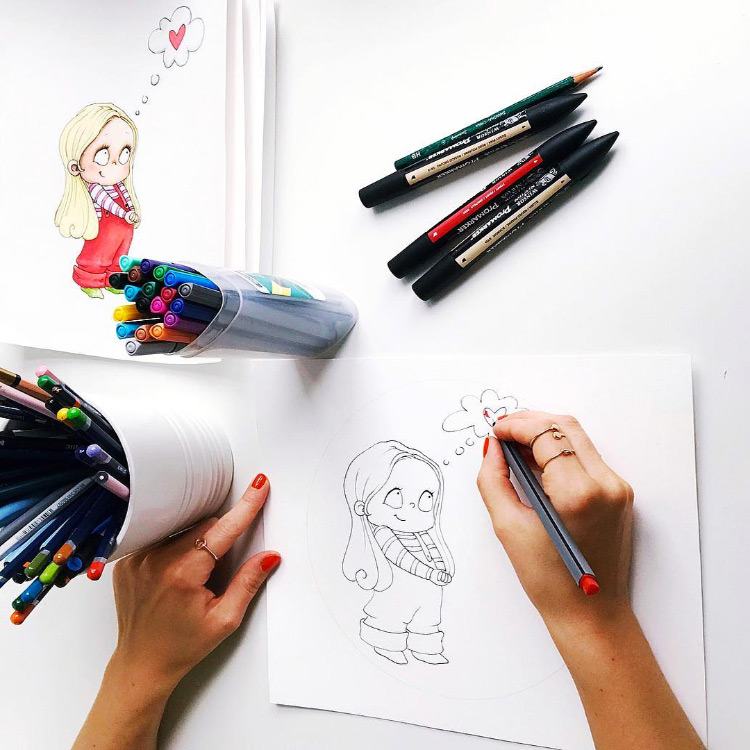
Even after you've worked with the same medium for a while in that location tin be some hesitation when starting a new project. Overcoming the fear associated with artist cake is an important step in keeping up with do.
There'southward also a theory that compares broken sleep patterns with increased creativity. A lot of artists and writers wake up early(around 3am-4am) and bound straight into drawing, painting, or anything that involves an absolute need for creativity.
This article by Karen Emslie shows ane person'south experience implementing broken sleep induced creativity into their routine and a little more background data on the theory itself.
This can exist especially helpful with brainstorming since information technology's meant to focus on rapid output that can be edited and refined later on.
Drawing from real life is besides something you should practice often. In fact, it's arguably one of the about important things you can exercise.
Seeing an object with your own ii optics is different than cartoon from memory. The lines are often more crisp and it clears upwards any perspective issues.
E'er starting time small. Don't jump into something also big or unfamiliar; instead practice simple and familiar things to build some confidence.
When I first started taking foundation courses I discovered I had a problem with the depth of my drawings. Instead of sketching lightly and then adding layers of shading over it, I would brand the outline the deepest part of the drawing.
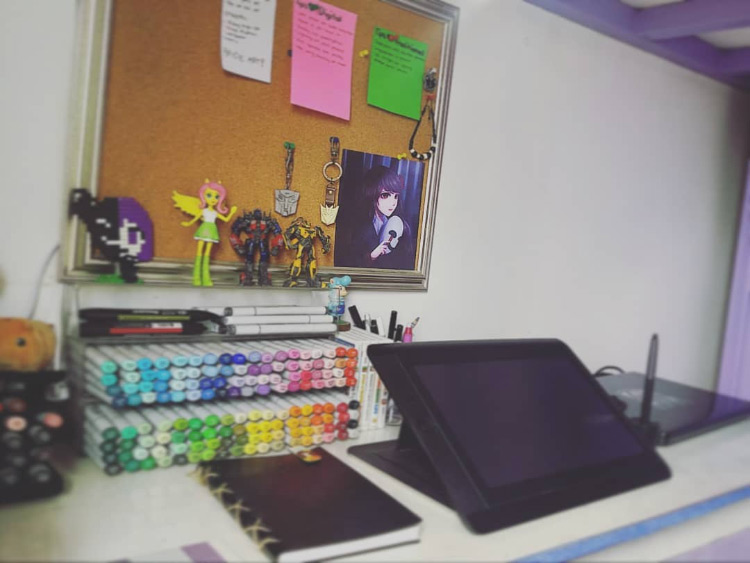
Layering allows the color to gradually build up and mold the image you are trying to create. You should be able to get virtually every value you need out of a regular HB(#2) pencil.
If you can't and so endeavour turning the pencil on its side rather than holding it completely vertical.
Completion of each piece should ever be the goal. Unless you feel admittedly stuck on a piece, in which case it's okay to put it away and come up dorsum to it when y'all've further developed that skill.
Simply the more than frequently yous complete pieces and the more you lot get into a regular routine, the more than you'll develop the skillset required to depict awesome things.
What To Practice
One time you gear up up a space and experience more than consistent with sketching then you lot'll want to figure out what to focus on(likewise drawing from life).
Sometimes information technology can be hard to remember of a new idea or concept for a new piece, especially as a new artist.
1 way to combat this is to take some exploration courses. Whether that ways physically registering for a class and attending with other people, or watching a tutorial from the comfort of your home. Both are great.
For in person classes I recommend going to a customs center or university and looking for opportunities there.
I took a drawing course and watercolor grade at a local spot and got to participate in my first gallery showing. Opportunities are everywhere.
A great online resource is the Proko video series.
These are very helpful for people who don't have a large corporeality of fourth dimension to spend in a classroom, or for people who can't commute or just don't have time for classes.
You can piece of work remotely and on your own fourth dimension by studying from a guy who really knows art.
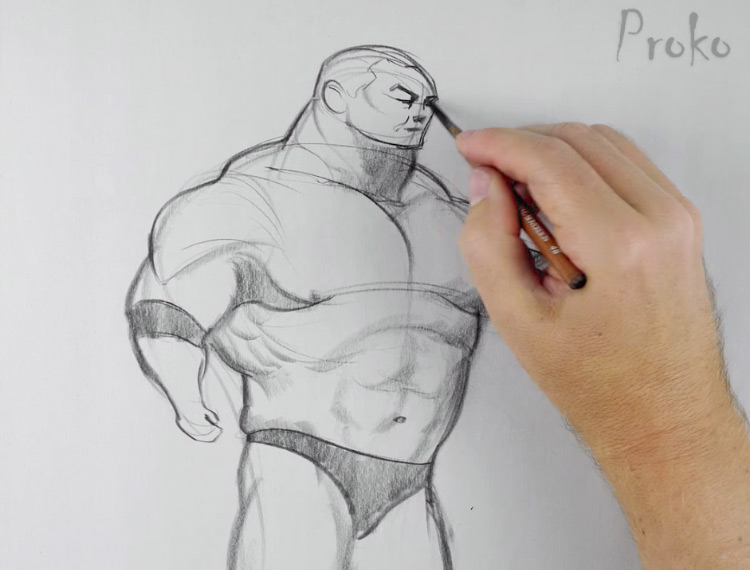
Proko'due south effigy drawing form is the perfect chance to get-go thinking about art realistically while likewise experimenting from imagination.
The serial will teach you to break downwardly complex figures into easily reproducible shapes to help fine-melody your fundamentals.
Keeping a level of fluidity within a pose is huge part of creating a realistic cartoon. Especially when drawing people.
Past breaking down each epitome into parts & shapes you'll larn how to rebuild the pose yourself, fifty-fifty from your imagination without a reference.
We wrote a detailed review of the figure course which includes some background info plus details on the structure of the course.
There's also free videos on the Proko YouTube channel that might provide more insight into what it offers. Simply no question the Proko series is an first-class reply to any new creative person who's wondering "what should I be practicing?"
Using References
References are very helpful for beginners(and pros as well!)
It'south of import to use references to pinpoint anatomical aspects of a drawing and to learn to draw from something rather than just from your imagination.
References help you refine and experiment with personal style.
Looking at other artists' works can influence your slice and spark creativity or requite you new ideas to try.
The most obvious form of reference is direct observation. This means y'all would be drawing from real life. I've constitute this is the easiest manner to actually smash down perspective and speed up the learning process.
But y'all tin too study from photographs which are certainly better than nothing!
If you want neat reference photos to work from then accept a expect at our list of free websites that offer thousands of totally free reference pics for artists.
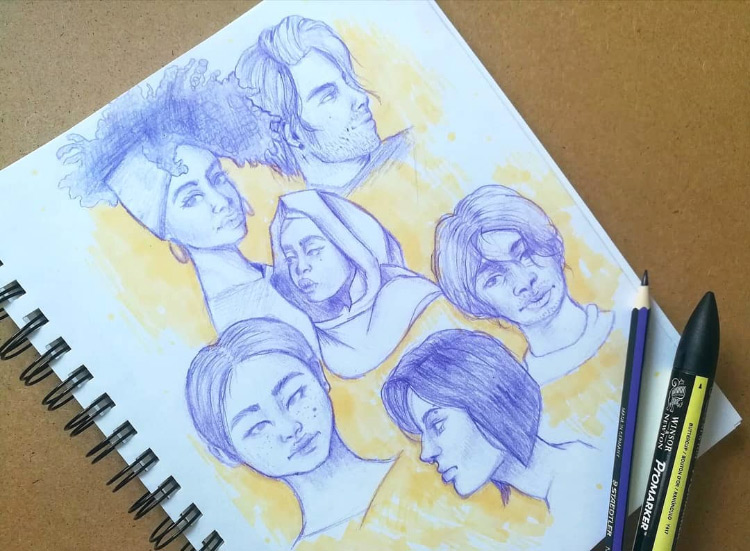
Keeping your practice piece of work closer to realism is easier when yous take other objects to compare against. So recall to go on practicing from life and from reference forth with your imaginative work; both are very important for growth.
Experimentation
Another affair to keep in mind is that art should exist fun, just it should also be challenging.
The merely way you will go meliorate is to try things you haven't washed earlier. This is extremely important if you get bored easily and need to be able to work on multiple projects at in one case.
Experimentation also allows you to go along progressing and widening your skill ready.
If yous usually stick to more traditional mediums and so try moving into paints or even digital work.
Fiber arts are also very fun and stress-free to larn inbetween larger pieces.
Let others lead by case. Bank check out your favorite artist's social media and examine their progression through different mediums and styles.
Seeing others attempt something new could help you do the same.
Mixed-Media art is also very popular correct at present so if you're not comfortable jumping straight into another course of art you lot tin try slowly adding in new mediums.
Some common pairings are ink and watercolor/gouache, fiber and resin, or alcohol markers and colored pencils.
Adding Colour
If black and white feels also boring then information technology'southward worth eventually adding color. Before transitioning into the world of bright hues it's important to know a piffling bit well-nigh colour theory.
This means learning about the color wheel and which colors go all-time together in order to create a sense of cohesion throughout a slice.
A normal color wheel includes the main colors(reddish, yellowish, and blue), secondary colors (violet, orangish, and greenish), and the tertiary colors (red-violet, red-orange, yellowish-orange, yellowish-green, blue-greenish, and bluish-violet).
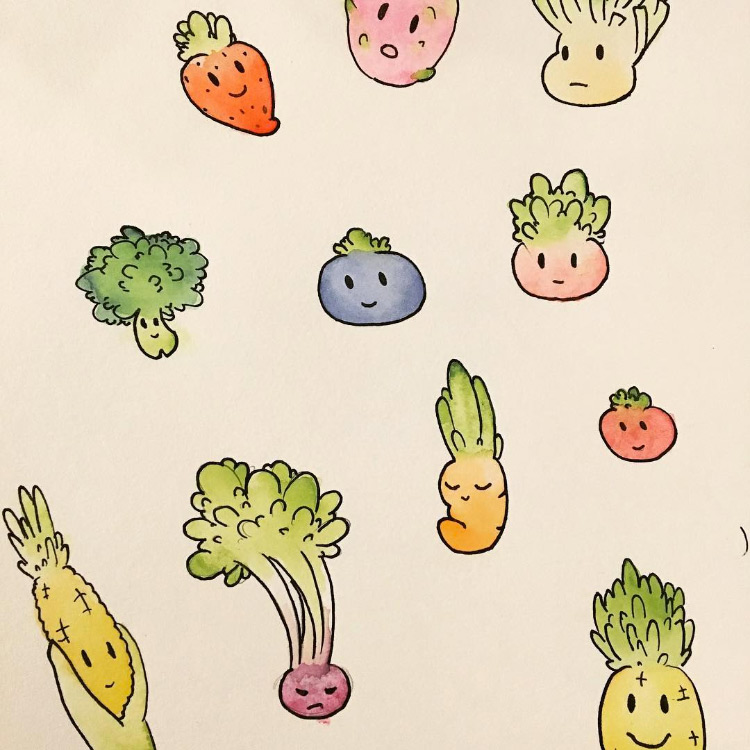
Complementary colors are directly across from each other on the color wheel.
These brand each other pop on the page when placed near, adjacent to, or on top of one another.
For example, red and green aren't paired together "but because".
They force your eyes to focus on the object that uses those colors.
It can too be difficult if you're working with basic shades of dark-brown or white. In that case yous have to look at the undertones in the pigment to see what shade works well with other colors yous're using.
If you're brand new to colors you can also try doing a color study. As a beginner information technology can be difficult to to decide the exact colors you want on a piece or what yous want the focal signal to be.
Sometimes information technology's easier to accept a copy of the colour wheel on hand.
A color study is a way to do laying downwards colors without potentially damaging or dulling out a piece. This style, y'all can explore a diversity of colour options before actually calculation any color to your project.
Simply ultimately art is simply about practice, repetition, and being willing to endeavor new things.
The only matter it takes to get an artist is 1 trait: tenacity.
The more you practice, the better you will get.
Being an creative person is nigh experiencing new things and about individual creation. If yous keep trying new mediums and new techniques yous'll learn to incorporate more of them into finished projects and round out your skill set.
The biggest thing when practicing art is to never surrender. If yous just keep practicing then it doesn't matter how old you are, where yous are in life, or how much time you've been at it.
Only keep practicing and trying to improve every single day. The results will follow.
Source: https://conceptartempire.com/how-to-be-an-artist/
0 Response to "How To Become An Artist: What It Takes To Practice Art (And Keep Learning)"
Post a Comment